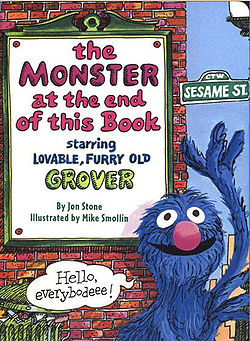
The Monster at the End of This Book: Starring Lovable, Furry Old Grover
Encyclopedia

Postmodernism
Postmodernism is a philosophical movement evolved in reaction to modernism, the tendency in contemporary culture to accept only objective truth and to be inherently suspicious towards a global cultural narrative or meta-narrative. Postmodernist thought is an intentional departure from the...
children's book based on the television series Sesame Street
Sesame Street
Sesame Street has undergone significant changes in its history. According to writer Michael Davis, by the mid-1970s the show had become "an American institution". The cast and crew expanded during this time, including the hiring of women in the crew and additional minorities in the cast. The...
and starring Grover
Grover
Grover is a Muppet character on the popular television show Sesame Street. Self-described as lovable, cute and furry, he is a monster who almost never uses contractions when speaking or singing....
. It was written by Jon Stone
Jon Stone
Jon Stone is best known for writing and producing Sesame Street, and is credited with helping develop characters such as Big Bird, Cookie Monster and Oscar the Grouch. He is regarded by many as one of the best children's television writers. He started working for children's programs in 1955...
and illustrated by Michael Smollin, and originally published by Golden Books in 1971 (ISBN 0-307-01085-6). It is the best selling Sesame Street title and Sesame Workshop also released this as an audio enabled free eBook with highlights on December 7, 2009. It is designed to teach children the technique of reading a book from beginning to end.
Plot
In this book, Grover is horrified to learn that there is a monster at the end of the book, and begs the reader not to finish the book, so as to avoid the monster.Fearful of reaching the end of the book, Grover constructs a series of obstacles, such as attempting to tie pages together and laying brick walls, to prevent the reader from advancing.
Increasingly frightened (and also in awe of the reader's strength at overcoming the obstacles), Grover pleads with the reader to stop reading as the book nears its conclusion.
However, the monster turns out to be Grover himself, making the story self-referential
Self-reference
Self-reference occurs in natural or formal languages when a sentence or formula refers to itself. The reference may be expressed either directly—through some intermediate sentence or formula—or by means of some encoding...
. Grover jokes that he tried to convince the reader that the monster would not be scary – but we see at the end that he is embarrassed.
Sequel
A sequelSequel
A sequel is a narrative, documental, or other work of literature, film, theatre, or music that continues the story of or expands upon issues presented in some previous work...
, Another Monster at the End of This Book: Starring Lovable, Furry Old Grover, and Equally Lovable, Furry Little Elmo (ISBN 0-375-80562-1), was published in 1996. It was also written by Stone and illustrated by Smollin, and features Grover and the ubiquitous Elmo
Elmo
Elmo is a Muppet character on the children's television show Sesame Street. He is a furry red monster and currently hosts the last full 15 minute segment on Sesame Street, Elmo's World, which is aimed at toddlers. His puppeteer, Kevin Clash, uses falsetto to produce his voice...
.
In other media
A reference to the books is made in the March 2, 2004 installment of Dinosaur ComicsDinosaur Comics
Dinosaur Comics is a constrained webcomic by Canadian writer Ryan North. It is also known as "Qwantz", after the site's domain name, "qwantz.com". The first comic was posted on 1 February 2003, though there were earlier prototypes. Dinosaur Comics has also been printed in two collections and in a...
.
A reference to the books is made in the January 18, 2011 installment of Sheldon (webcomic).
The TV series Supernatural had an episode with the same name.

